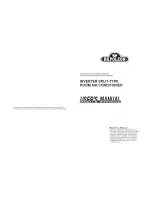
18
AIR PURGING / TEST RUNNING
Use of a vacuum pump
(For method of using a manifold valve, refer to its operation manual.)
1. Completely tighten the flare nuts, A, B, C, D, connect the manifold valve charge
hose to a charge port of the low-pressure valve on the gas pipe side.
2. Connect the charge hose connection to the vacuum pump.
3. Fully open the handle Lo of the manifold valve.
4. Operate the vacuum pump to evacuate. After starting evacuation, slightly loose the
flare nut of the Lo valve on the gas pipe side and check that the air is entering
(Operation noise of the vacuum pump changes and a compound meter indicates 0
instead of minus).
5. After the evacuation is complete, fully close
the handle Lo of the manifold valve and stop
the operation of the vacuum pump. Make
evacuation for 15 minutes or more and
check that the compound meter indicates
-76cmHg (-1x10 Pa).
6. Turn the stem of the packed valve B about
45°counterclockwise for 6~7 seconds after
the gas coming out, then tighten the flare nut
again. Make sure the pressure display in the
pressure indicator is a little higher than the
atmosphere pressure.
7. Remove the charge hose from the Low
pressure charge hose.
8. Fully open the packed valve stems B and A.
9. Securely tighten the cap of the packed valve.
Test running
Safety and leakage test
Electric safety check
Perform the electric safe check after completing installation:
•
Insulated resistance
The insulated resistance must be more than 2 M
Ω
.
•
Grounding work
After finishing grounding work, measure the grounding resistance by visual detection
and grounding resistance tester. Make sure the grounding resistance is less than 4
Ω
.
•
Electrical leakage check (performing during test running)
During test operation after finishing installation, the serviceman can use the electro
probe and multimeter to perform the electrical leakage check. Turn off the unit
immediately if leakage happens. Check and find out the solution ways till the unit
operate properly.


































